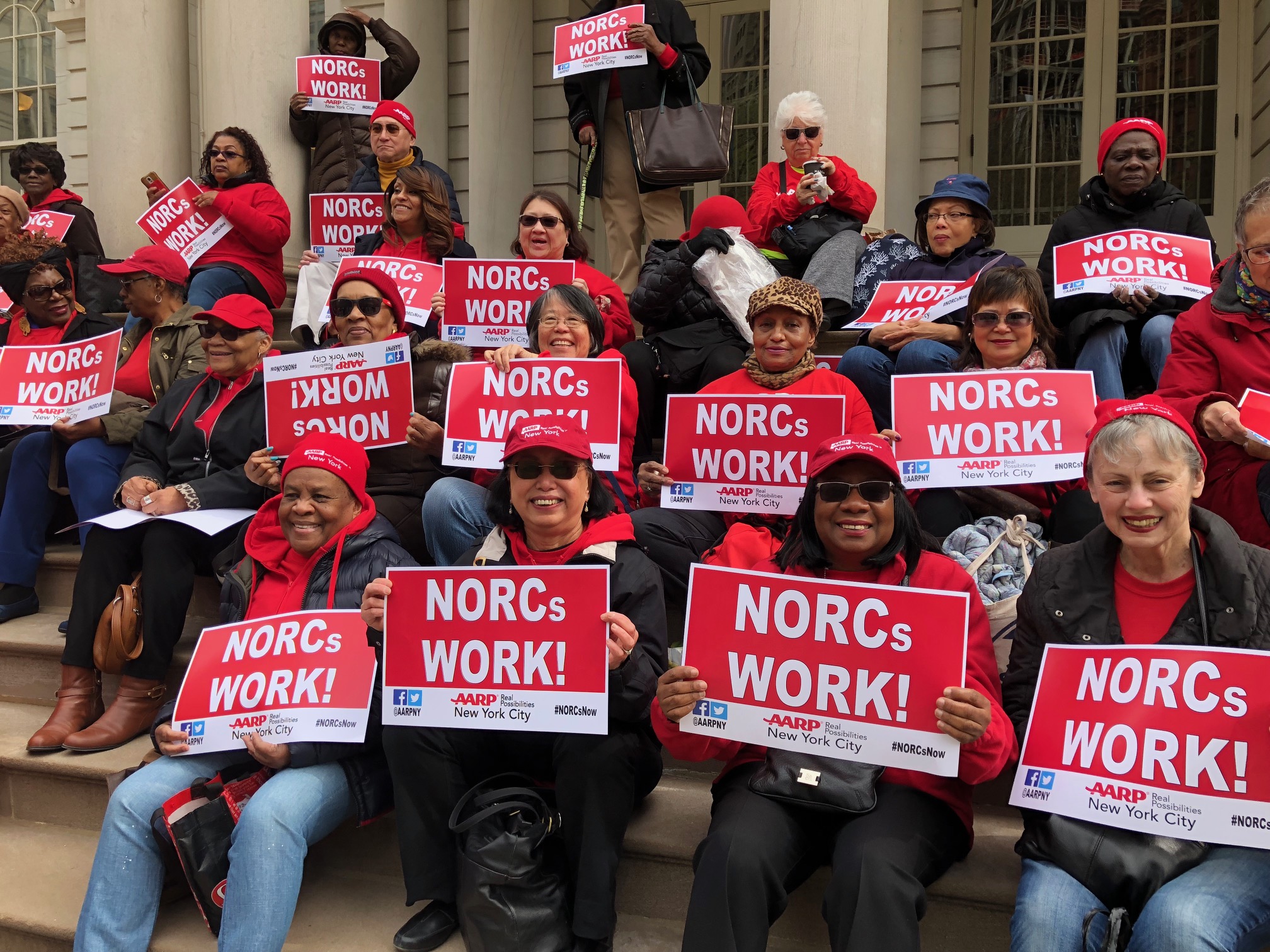AARP Eye Center

AARP New York members, NYC aging advocates United Neighborhood Houses, LiveOn NY, UJA-Federation of New York, and Council Members Margaret Chin and Paul Vallone, rallied on the steps of City Hall on Monday, April 30, to call for increased funding for Naturally Occurring Retirement Communities (NORCs). Located in buildings or neighborhoods with high concentrations of senior citizens, NORCs provide services, including case management and health assistance, that help older New Yorkers to age in their homes, rather than in costlier—mostly taxpayer funded— institutional care.
There are more than 1.2 million seniors (65+) in NYC, and nearly 2.8 million New Yorkers are 50+. As a result of the boomer generation aging, the senior population in NYC is exploding, projected to increase 40% between 2010 and 2040. That’s why AARP New York is calling on the city to increase funding for NORCS by 40%, to $6 million, to better address the needs of this growing population.
“New Yorkers overwhelming report that they want to stay in their neighborhoods, and better yet in their homes, as they age,” said Beth Finkel, State Director of AARP New York. “In order to help them do this in a healthy and safe way, we must fund services that support aging. One of the best ways to reach many seniors at a time is through NORCs.”
While there are currently 53 designated NORCs, there are not enough in areas with high concentrations of New Yorkers 50+ to serve the city’s growing need, and investment has not kept pace. One-third of the population in 24 city council districts is already over the age of 50. Some of those districts have one or no NORCs. According to a report issued by City Comptroller Scott Stringer, almost 30 percent of NORCS are concentrated in a few districts in Lower Manhattan, South Brooklyn and Western Queens. Neighborhoods with high concentrations of seniors and no NORCs include Forest Hills & Rego Park, Queens Village, Cambria Heights, Rosedale, Tottenville, Great Kills and Annadale.
“As our city’s senior population rises, we must invest in safe, high-quality affordable housing with services so that older adults can age in place in the communities they’ve called home for decades,” said Allison Nickerson, Executive Director for LiveOn NY. “We urge the City Council to increase funding for NORCs to allow the growing aging population the opportunity to be connected to these supports and services and so that NORCs can build and expand programs. The aging in place model is a cornerstone of our collaborative efforts to make New York a better place to age."
"UJA-Federation helped establish the first New York City NORC in 1986, bringing an innovative model of caring to our city that has enabled thousands of New Yorkers to live independently - with dignity, comfort, and security. For the sake of the growing number of older adults and their families who rely on NORCs for a better quality of life, we urge the City Council and the Administration to increase funding," said Louisa Chafee, Senior Vice President, UJA-Federation of New York.
“Naturally Occurring Retirement Communities (NORCs) are a critical tool for maintaining the fabric of communities while helping older adults age with dignity in their homes. We appreciate the City’s support for this innovative model— and in particular note Councilmember Chin’s leadership—but current funding levels do not fully account for the cost of delivering high-quality services. We urge the City Council to increase its investment for NORCs in FY2019 in order to help existing NORCs cover increases in nursing costs, as well as to pilot new NORC programs in underserved communities throughout the City,” said Kevin Douglas, Co-Director of Policy and Advocacy at United Neighborhood Houses.
Follow us on Twitter: @AARPNY and Facebook: AARP New York
AARP is a nonprofit, nonpartisan organization, with a membership of nearly 38 million that helps people turn their goals and dreams into 'Real Possibilities' by changing the way America defines aging. With staffed offices in all 50 states, the District of Columbia, Puerto Rico, and the U.S. Virgin Islands, AARP works to strengthen communities and promote the issues that matter most to families such as healthcare security, financial security and personal fulfillment. AARP also advocates for individuals in the marketplace by selecting products and services of high quality and value to carry the AARP name. As a trusted source for news and information, AARP produces the world’s largest circulation magazine, AARP The Magazine and AARP Bulletin. AARP does not endorse candidates for public office or make contributions to political campaigns or candidates. To learn more, visit www.aarp.org or follow @AARP and our CEO @JoAnn_Jenkins on Twitter.























































